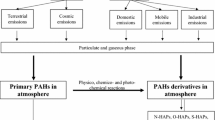Abstract
The level of mutagenic activity of particulate polycyclic aromatic hydrocarbons (PAHs) is highly dependent upon structure, so that similar isomers can range from being very active to totally inactive. The suitability of GC/MS or LC with single wavelength absorbance or fluorescence monitoring, coupled with the availability of standards, has resulted in emphasis being placed on the small PAHs (five or fewer rings).
In the work reported here, LC was coupled to a computerized photodiode array detector. The former separated the components in a diesel particulate matter extract and the latter spectrally differentiated the large PAHs (more than 24 ring-carbons). Since each PAH has a characteristic UV/VIS absorbance spectrum, each generated a unique pattern of absorbance maxima and minima. Computerized pattern recognition techniques were then used to investigate quantitative structure-activity relationships of the PAHs as predictors of carcinogenicity.
The chemical profile of a series of unsubstituted PAHs, for which carcinogenic data was available, was represented by 17 descriptors of the reactivity and properties of those PAHs. Using this data set, the properties of another series of PAHs were found to be consistent with their reported carcinogenicity.
Similar content being viewed by others
References
Borgen, A., Darvey, D., Castagnoli, N., Crocker, T. T., Ramussen, R. E. and Wang, I. Y.: 1973, ‘Metabolic Conversion of Benz[a]pyrene by Syrian Hamster Liver Microsomes and Binding of Metabolites to Deoxyribonucleic Acid’, J. Med. Chem. 16, 502–506.
Cammarata, A. and Menon, G. K.: 1976, ‘Pattern Recognition. Classification of Therapeutic Agents According to Pharmacophores’, J. Med. Chem. 19, 739–748.
Chou, J. T. and Jurs, J. C.: 1979, ‘Computer-Assisted Structure-Activity Studies of Chemical Carcinogens. An N-nitroso compound data set’, J. Med. Chem. 22, 792–797.
Clar, E.: 1972, The Aromatic Sextet, Wiley-Interscience, New York, 128pp.
Dunn, W. J. III and Wold, S.: 1981, ‘An Assessment of the Carcinogenicity of N-nitroso compounds by the SIMCA Method of Pattern Recognition’, J. Chem. Inf. Comput. Sci. 21, 8–13.
Harvey, R. G. (Ed.), 1985, Polycyclic Hydrocarbons and Carcinogenesis, ACS Symposium Series No. 283, American Chemical Society, Washington, D.C., 374 pp.
Jerina, D. M. and Lehr, R. E.: 1977, ‘The Bay Region Theory: A Quantum Mechanical Approach to Aromatic Hydrocarbon-induced Carcinogenicity’, In Microsomes and Oxidations (Roots, I., Hildebrandt, A. G., Estabrook, R. E. and Conney, A. H., (Eds.) Pergamon Press, Oxford, pp. 709–720.
Jinno, K.: 1984, ‘The Quantitative Structure-Activity Relationship Approach to the Mutagenicity of N-nitrosomethylaniline Compounds’, Mut. Res. 141, 141–143.
Jurs, P. C., Chou, J. T. and Yuan, M.: 1979, ‘Computer-Assisted Structure-Activity Studies of Chemical Carcinogens. A Heterogeneous Data Set’, J. Med. Chem. 22, 476–483.
Lewi, P. J.: 1976, ‘Computer Technology in Drug Design’, In Drug Design, Vol. 7 (Ariens, E. J., Ed.) Academic Press, New York, pp. 209–278.
Lewi, P. J.: 1981, ‘Multivariate Data Analysis in Structure-Activity Relationships’, In Drug Design, Vol. 10 (Ariens, E. J., Ed.), Academic Press, New York, pp. 307–342.
Lewtas, J. (Ed.): 1982, Developments in Toxicology and Environmental Science, Volume 10: Toxicological Effects of Emissions from Diesel Engines, Elsevier Biomedical, Amsterdam, 380 pp.
Loew, G. H., Phillips, J., Wong, J., Hielmeland, L. and Pack, G.: 1978, ‘Quantum Chemical Studies of the Metabolism of Polycyclic Aromatic Hydrocarbons: Bay Region Reactivity as a Criterion for Carcinogenic Potency’, Cancer Biochem. Biophys. 2, 113–122.
Miyashita, Y., Takahashi, T., Yotsui, Y., Abe, H. and Sasaki, S.: 1981a, ‘The Use of Cluster Analysis and Display Method of Pattern Recognition in Structure-Activity Studies of Antibiotics’, CODATA Bull. 41, 37–41; 1981b, ‘Application of Pattern Recognition to Structure-Activity Problems: Use of Minimal Spanning Tree’, Anal. Chim. Acta. 133, 615–624.
Miyashita, Y., Seki, T., Takahashi, Y., Daiba, S., Tanaka, Y., Yotsui, Y., Abe, H. and Sasaki, S.: 1981, ‘Computer-Assisted Structure-Carcinogenicity Studies on Polycyclic Aromatic Hydrocarbons by Pattern Recognition Methods’, Anal. Chim. Acta. 133, 603–613.
Miyashita, Y., Takahashi, Y., Daiba, S., Abe, H. and Sasaki, S.: 1982, ‘Computer-Assisted Structure-Carcinogenicity Studies on Polynuclear Aromatic Hydrocarbons by Pattern Recognition Methods: The Role of the Bay and L-Regions’, Anal. Chim. Acta. 143, 35–44.
Miyashita, Y., Okuyama, T., Yamaura, T., Jinno, K. and Sasaki, S.: 1987, ‘Prediction of Carcinogenicity of Polynuclear Aromatic Hydrocarbons on the Basis of their Chemical Structures’ Anal. Chim. Acta. 202, 237–240.
Petit, B., Potenzone, R. Jr., Hopfinger, A. J., Klopman, G. and Shapiro, M.: 1979, ‘A Hierarchal QSAR Molecular Structure Calculator Applied to a Carcinogenic Nitrosamine Database’, In Computer-Assisted Drug Design (Olson, E. C. and Christofferson, R. E., Eds.) ACS Symposium Series No. 112, American Chemical Society, Washington, D. C., pp. 553–581.
Pullman, A. and Pullman, B.: 1955, ‘Electronic Structure and Carcinogenic Activity of Aromatic Molecules: New Developments’, Adv. Cancer Res. 3, 117–169.
Scribner, J. D.: 1975, ‘Molecular Orbital Theory in Carcinogenesis Research’, J. Natl. Cancer Inst. 55, 1035–1038.
Sims, P., Grover, P. L., Swaisland, A., Pal, K. and Hewer, A.: 1974, ‘Metabolic Activation of Benzo[a]pyrene Proceeds by a Diol Epoxide’, Nature, 252, 326–328.
Smith, I. A., Berger, G. D., Seybold, P. G. and Serve, M. P.: 1978, ‘Relationships between Carcinogenicity and Theoretical Reactivity Indexes in Polycyclic Aromatic Hydrocarbons’, Cancer Res. 38, 2968–2977.
Stuper, A. J., Brugger, W. E. and Jurs, P. C.: 1979, Computer-Assisted Studies of Chemical Structure and Biological Function, Wiley-Interscience, New York, 220pp.
Author information
Authors and Affiliations
Rights and permissions
About this article
Cite this article
Jinno, K., Miyashita, Y., Sasaki, SI. et al. Separation of large polycyclic aromatic hydrocarbons in particulate matter by liquid chromatography. Environ Monit Assess 19, 13–25 (1991). https://doi.org/10.1007/BF00401293
Issue Date:
DOI: https://doi.org/10.1007/BF00401293




